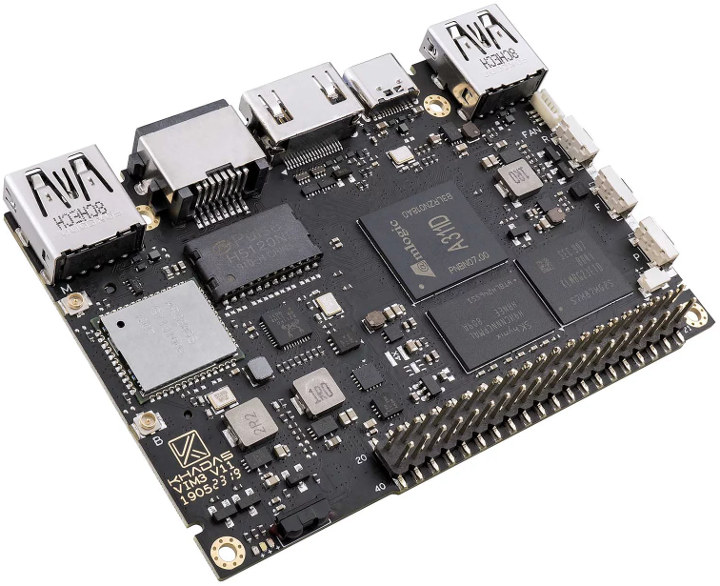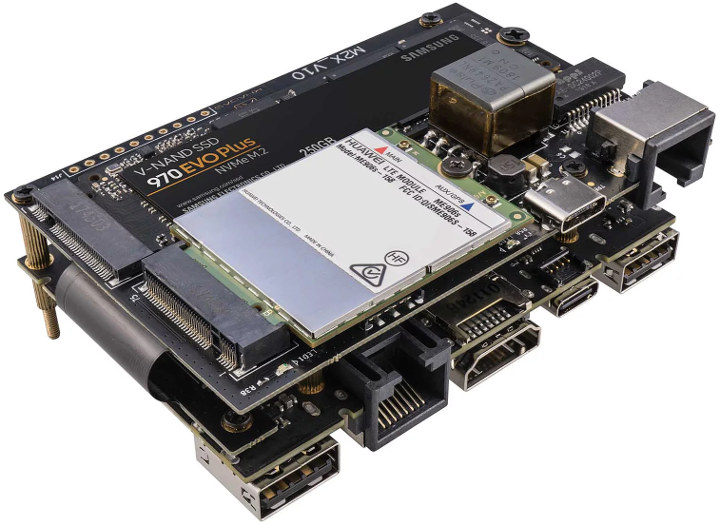We’ve previously written about Khadas VIM3 Amlogic S922X development board and revealed the price tag for VIM3 Basic ($69.99) and VIM3 Pro ($99.99) with a launch date announced for June 24. As time has passed, this has become “fake news” except for the launch date, as Khadas VIM3 SBC has indeed launched but for $99.99 (Basic) and $139.99 (Pro).
What’s going on? Why the large price increase? That’s because Khadas team has decided to provide a more powerful platform to the community, and replace Amlogic S922X processor with Amlogic A311D processor boasting higher clock speeds and a 5.0 TOPS NPU. Another version may also become available later on with the soon-to-be-released Amlogic S922X-B processor whose Cortex-A73 cores are clocked at up to 2.2 GHz, instead of 1.7 GHz for the original Amlogic S922X processor that will be referred to Amlogic S922X-A in the future.

New Khadas VIM3 SBC specifications:
- SoC – Amlogic A311D hexa-core processor with 4x Arm Cortex-A73 cores @ up to 2.2 GHz and 2x Cortex A53 cores @ up to 1.8 GHz, Arm Mali-G52 MP4 GPU, built-in Cortex-M4 core for “always-on” processing, and 5.0 TOPS NPU @ 800 Mhz with support for Tensorflow, Caffe and other deep-learning frameworks
- MCU – STMicro STM8S003 with Programmable EEPROM for power management, customizations, and boot media configuration
- System Memory & Storage
- VIM3 Basic – 2GB LPDDR4/4X RAM, 16GB eMMC 5.1 flash
- VIM3 Pro – 4GB LPDDR4/4X RAM, 32GB eMMC 5.1 flash
- Common – 16MB SPI flash, microSD card slot supporting up to UHS-I SDR104, support for M.2 2280 NVMe SSD (see Expansion section)
- Video Output & Display Interface
- HDMI2.1 transmitter with 3D, Dynamic HDR, CEC, and HDCP 2.2 support
- 30-pin 0.5mm Pitch FPC Connector for 4-lane MIPI-DSI interface up to 1920 x 1080
- 10-pin 0.5mm Pitch FPC connector for touch panel
- Video
- 4K UHD H.265 75fps 10-bit video decoder & low latency 1080p H.265 / H.264 60fps decoder
- Supports multi-video decoding up to 4Kx2K@60fps + 1x1080P@60fps
- Dolby Vision and HDR10, HDR10+, HLG, and PRIME HDR video processing
- Audio – 8-ch I2S for microphone array applications over M2. connector
- Camera – 30-pin 0.5mm Pitch FPC connector for 4-lane MIPI CSI with dual camera support; 8MP ISP
- Connectivity
- Gigabit Ethernet with WoL support
- Dual-band 802.11a/b/g/n/ac WiFI 5, 2X2 MIMO with RSDB and Bluetooth 5.0 via Ampak AP6398S module
- USB – 1x USB 3.0/2.0 type-A port, 1x USB 2.0 type-A port, 1x USB 2.0 OTG type-C port with USB PD support
- Sensor – KXTJ3-1057 3-axis digital accelerometer
- Expansion
- M.2 Socket with single lane PCIe 2.0, USB 2.0, I2S, I2C, ADC, 100M Ethernet PHY interface, GPIO, MCU_PA2
- 40-pins 2.54mm pitch header exposing:
- CPU signals – USB, I2C, I2S, SPDIF, UART, PWM, ADC
- MCU signals – SWIM, NRST, PA1
- Misc – 2x IR receivers; RTC & battery header; 4-pin cooling fan header with PWM speed control; 3x user LEDs; power, func and reset buttons; XPWR pads for an external power button
- Power Supply – 5V to 20V via USB-C port or pogo pads
- Dimensions – 82.0 x 58.0 x 11.5 mm (4x M2 mounting holes)
- Weight – 28.5 grams
- Certifications – CE, RoHS
So basically nothing has changed from the specifications, except for the faster processor which also includes a 5 TOPS NPU, and a MIPI CSI camera interface. If you’d want to reproduce a similar configuration with ODROID-N2 or Raspberry Pi 4, you’d need to spend $60-$70 extra to get a neural compute stick, but obviously that only makes sense if your application can leverage AI acceleration.

Optional accessories include a new VIM Heatsink, a 3705 Cooling Fan, M2X extender board for NVMe SSD (pictured above), a TS050 Touchscreen, Khadas Tone board, a DIY Case, an IR Remote, a USB-C 24W adapter, and related USB-C cables, as well as an HDMI cable.
The company will provide Ubuntu 18.04+ with mainline Linux (Linux 5.0 or greater), as well as Android 9.0 Pie support, and they also mentioned LibreELEC and Armbian support for the boards. You’ll find more technical details and instructions to get started in Khadas documentation website.
If you are interested, you can purchase the board and/or accesories directly on Khadas shop.

Jean-Luc started CNX Software in 2010 as a part-time endeavor, before quitting his job as a software engineering manager, and starting to write daily news, and reviews full time later in 2011.
Support CNX Software! Donate via cryptocurrencies, become a Patron on Patreon, or purchase goods on Amazon or Aliexpress. We also use affiliate links in articles to earn commissions if you make a purchase after clicking on those links.





Will you receive one for testing CNX ?
Yes, I should get one but it will take a while before I post a review, as I’ve accepted a bit too many hardware platforms for review.
Bright side, better to have more choices than non. 🙂
Yes, we will ship the VIM3 sample soon 🙂
Pricing is a joke, A311D only costs an extra few $ over an S922X and does not justify a $40 increase, I can see this product being a total flop with the introduction of the RPi4.
Khadas folks say: VIM3 pricing of $69.99 (Basic) & $99.99 (Pro), were promotional prices, which ended on 24th June. Retail prices are $99.99 (Basic) & $139.99 (Pro). The difference in prices are not due to a change of SoC. You can still get $20-off VIM3 (until 22nd July)!
And I agree that these prices might become a problem especially with the RPi 4 being launched at the same time.
I hope khadas does not try to do the same wetek
For the future we already know well.
The end is always the same!
See what mecool did with wetek.
Same models different values.
Always manufacturing late and wanting to sell with the higher price.
Good luck.
I can’t see where these two boards are overlapping. They’re for different use. The khadas is more like Jetson nano, bit instead of using the cuda gpu it has a dedicated accelerator for keras and tensorflow.
I would benchmark and compare Jetson nano and this board for running some CNN or RNN model.
What resolution is the camera? What are the video encoder specs?
These AI cores aren’t very useful without input data to process on.
SoC datasheet here https://docs.khadas.com/vim3/HardwareDocs.html
Video/Picture Encoding
o Independent JPEG and H.265/H.264 encoder with configurable performance/bit-rate
o JPEG image encoding
o H.265/H.264 video encoding up to 1080P@60fps with low latency
o DVP (ITU 601/656) camera interface
o Supports YUV or RGB camera input formats
Camera Interface
• DVP parallel and MIPI-CSI camera interface with 4 lanes
• Supports RAW, YUV or RGB camera input formats
• Built-in 8MP HDR Image Signal Processor (ISP)
• Built-in image distortion correction engine
You can have 4K sensors, but only encode at 1080P60. Not great at this price point. RK1808 much better deal even though it is only 1080P30. AI on this chip is likely to only be used for voice processing, and it is overkill for that.
MIPI CSI host has the following features.
Support up to 2 cameras, up to 8M pixel sensors, up to 60 fps
1 x 8Mpix x 60fps, or 1x 8Mpix x 30fps x 2exp
2 x 4Mpix x 60fps, or 2x 8Mpix x 30fps
Supports max resolution of 3840*2160@60fps
—————————————-
If someone makes a chip with 4K sensor, 4K encode and AI coprocessor for $6 — it will sell well. RV1109 due in fall has those specs, but price is unknown. Allwinner V536 has the 4K pipeline but it lacks the AI coprocessor – it is $6.50.
Agree, but different with the upcoming Amlogic C302/5/8 SoCs(without decoder) for Smart IP Camera, the A311D target high-end applications like Smart NAS.
BTW, Rockchip will launch a cost down RK1806 (PIN to PIN with RK1808) soon.
How will RK1806 differ from the RK1808? RK1808 already has a weak CPU and encode pipeline, what could they take out of it and still leave a useful chip? Maybe eliminate USB3/PCIe.
Beware that the cooling fan is not yet available. The announced cooling fan for the updated VIM2 still hasn’t shipped either! Not sure why it’s taking months to source the and ship the cooling fan.
The VIM2 use an existing & standard 3004 cooling fan from a Taiwan vendor, the 3004 fan is a slim and high-speed one and the performance is fine for VIM2 but with a little bit noise which is not acceptable for HTPC users.
That’s one of the reason why we decide to design a new cooling fan with a Japan motor manufacturer for better performance and less noise, another reason is that we also need a better solution for new SoCs like RK3399, A311D and even RK3588. We finally customized the new fan with dimensions of 37*5.MM to suit our SBC boards, the 3705 cooling fan can work for VIM2(V14), VIM3, Edge & Edge-V.
Due to the motor need a high precision mold, and we adjusted many times to match our standard, the whole progress is indeed much slower than we expected, but I trust we can delivery the 3705 fan in next month:
https://dl.khadas.com/test/Fan3705_mold.JPG
Well, just make a passive cooled device. More heatsink but less headaches. I would definitely buy it if it weren’t for the stupid thermal design that you guys put in there, compared to other sbc manufacturers.
Placing the SoC under the board would definitely allow to use a very large plate and to better spread the heat.But given that there are already extensions supported under the board, this would require to redesign the whole board’s layout, which could also come with downsides and new issues. I don’t think we can expect to see this happening any time soon.
Larger heatsink, same fan, bigger height extended box top. Easier solution IMO.
The news of the non-exciting non-cheering Khada.
After the Odroid N2
After the Beelink GT-king
After the raspberry.
I’m wondering what khadas will want to show with these prices.
Do you think A311D outperforms S922? 🙂
Actually, A311D = S922X(B-Version) + MIPI-CSI + NPU. So the CPU performance should be same. But due to the S922X still with A-version now, so A311D with higher performance then S922X(A) now.
You can check the sbc-bench for the details:
https://github.com/ThomasKaiser/sbc-bench/blob/master/Results.md
Further details here:
https://www.khadas.com/post/khadas-vim3-won-t-use-s922x
Yes, I’ve seen tkaiser’s table. It looks like A311D is just overclocked (1.9GHz vs 2.2GHz on big cores) version of S922 A-Version, right?
Not sure if you already read the link I posted in previous comment, the 2.2GHz is not a overclocked freq on A311D or S922X(B-version, will ready soon I guess).
I think they meant to ask if the only performance difference between the A311D and S922X(A version) is due to the clock speed increase in the A311D.
Yes, I think so.
Well nvme surely compensates the lack of usb 3.0, still a pci express 3.0 would make the box more loveable to those who prefer to use it an media center/wi-fi drive storage, making it faster for multiple users at the same time. Otherwise, the new chipset remains a mystery to me. Will have to read more on how it compares to the s912 And how much the NPU accelerates the hexa-core vs octa-core. 🙂
@Gouwa, unlike the Khadas VIM3L (905D3), can USB3.0 and PCI-e be used at the same time in VIM3 (A311D)?
Also, is there any scope for reducing the price of VIM3Pro?
All recent Amlogic processors have the same limitation, it’s either USB 3.0 or PCIe.
VIM3 already available at Gearbest shop – 160 USD now:
https://www.gearbest.com/tv-box/pp_009455772206.html?wid=1349303&lkid=58802978